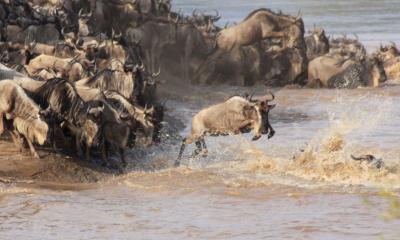
Animal migrations can have significant impacts on ecosystem processes through the transfer of resource subsidies across ecosystem boundaries. The effect of these wildlife subsidies is mediated by the subsidy form, which may occur as carcasses or egestion/excretion, and environmental characteristics, such as river flow level or background nutrient availability. In the Mara River of eastern Africa, there are two forms of wildlife subsidy transporting large amounts of resources from the savanna grasslands into the river. The largest remaining overland migration of over one million wildebeest results in periodic inputs of carcasses into the river, while feeding migrations by hippopotamuses result in daily inputs of egested grass transferred into the river. We hypothesize that these two different forms of animal input have different effects on river ecosystem function, and their magnitude and effects are mediated by discharge.
We are using a combination of field observations, in situ and mesocosm experiments, and simulation modeling to investigate how resource subsidies by hippos and wildebeest interact with each other and with discharge to affect river ecosystem function. Our research seeks to determine 1) the magnitude, composition, and mineralization rate of inputs by hippos and wildebeest, 2) how these inputs influence nutrient limitation, bacterial and algal production, and whole-river metabolism and nutrient uptake, and how these effects vary with discharge, 3) the degree to which wildlife subsidies are incorporated into the river food web and how this varies with discharge, and 4) how animal inputs in the Mara relate to overall nutrient loadings and ecosystem function in the system.
Our research will improve understanding of systems where large wildlife play an important role, and provide a baseline for comparison with systems where wildlife have disappeared or been replaced by cattle or humans. The Mara is one of the few remaining unregulated rivers heavily influenced by large wildlife populations, which provides an opportunity to understand how many ecosystems may have once functioned prior to megafaunal extinctions. This research also will contribute to an improved understanding of how anthropogenic changes in flow regimes and nutrient loading of rivers could affect their ability to process natural inputs. Very little river ecosystem science has been done in this region of the world, and integrating data from this river with other studies of large river metabolism and nutrient uptake will help broaden our conceptual understanding of the way natural rivers function. To read more about our research in the Mara River Basin, please visit www.marariverresearch.org.
Below David Post discusses our research in the talk “Migrating Wildebeest and Ragging Hippos” for Science on Saturday at Yale.
Watch this video to learn more about our research program:
Watch this video to learn about an exciting collaboration with Carnegie Mellon University robotics engineers:



